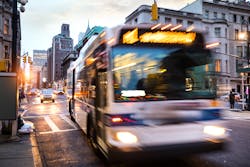A changing landscape serves as the catalyst for smart city initiatives
With the worldwide pandemic still raging, much of what we used to take for granted continues to be different. Less than a year ago, we didn’t think twice about hopping on a crowded bus or descending below ground to catch a subway train. Urbanization remained the trend, with newly minted college graduates and empty nesters moving downtown to take advantage of all the city had to offer, including great restaurants, sporting events, entertainment and of course, its energy.
Starting with China, then Italy, the rest Europe, the United States and ultimately, much of the rest of the world, people everywhere became familiar with words and concepts they had paid little attention to before the pandemic. The coronavirus, social distancing, wearing masks and timelines for vaccine development became the topics du jour; and then came the shutdowns, which resulted in a sharp economic downturn and the loss of jobs for millions of people worldwide.
When people don’t have jobs to get to, or they fear being too close to people, mass transit use declines substantially, which, for transit agencies, has meant temporary ridership declines as significant as 50 percent or more.
As we look forward, the expectation is that we will achieve some sense of normalcy once a vaccine is widely available, estimated to be sometime in the spring of 2021 for the general population. But many are wondering what “normal” will be at that point. Will people still wear masks in public places? Will they want to stay at a social distance? Will they prefer to live in the city or move to the suburbs?
These questions are largely unanswerable right now, but it’s safe to say that as the economy recovers and people come back to work, mass transit will continue to play a prominent role in getting people to where they need to be. The rules are likely to be different, however, and the need for technology to accommodate these differences will be paramount.
Undoubtedly, people will want to spend less time in transit, and they’ll care about the quality of the air filtration system on transit vehicles. They’ll also likely want more separation between passengers to prevent the chance of close contact with someone who is sick. Finally, passengers are going to want to know where their bus is and when they should arrive to the bus stop because they’re not going to want to wait at crowded bus stops any longer than necessary.
Beyond ventilation upgrades and other physical retrofits, it’s likely that transit buses and trains will need to run with lower passenger counts as the new norm. This will mean it’ll be important to do more with the same number of transit vehicles, meaning getting passengers from point A to point B as quickly and safely as possible. To do this, taking advantage of the fact that most buses and trains are connected via cellular communications will be key. Specifically, telematics data, such as transit vehicle location, speed, direction, estimated time of arrival, transit vehicle (and driver) performance, etc., will need to be pushed to a smart city cloud to be analyzed both in the moment for immediate actions and over time for comprehensive system optimization.
An example of this technology use would include priority control in the cloud environment, where the transit vehicle can push its location data to a central server and that location could be compared to where it’s supposed to be based on its schedule. If the bus is behind schedule, priority control can be enabled, requesting green lights ahead until it’s back on schedule. The same principles can be applied to achieve optimal headway between buses. Another use case could include technology used to speed the process of fare collection, thus reducing the time needed at bus stops.
Longer term, historical telematics data can enable end-to-end fleet management, with functions that increase driver and fleet safety, optimize maintenance and compliance processes, increase fuel efficiencies, ensure proper transit vehicle usage and reduce administration time by eliminating paper processes.
The conundrum, however, is that many agencies are seeing their budgets reduced, resulting in a lack of capital dollars available for the investments needed to optimize their operations. It’s a catch 22, but some vendors are offering their solutions as a service, which enables agencies to get the benefits of these solutions without the need for a capital outlay; service offerings are typically paid for with operating dollars and in some cases, the money saved by implementing the solution can be used to cover the as a service fee that enables the savings.
Prior to the pandemic, many smart city initiatives were viewed as important, but they lacked the catalyst to drive them to the point of being completely necessary for the sustainment of the services being provided. As we make our way through the many changes we’ve had to endure since early in 2020, life will surely start to go back to normal. But “normal” is being redefined and it’s becoming increasingly clear that the use of technology to keep people safe and agencies financially viable will be critical to the future of mass transit.
About the Author

Mike Haldane
Vice President of Marketing, Global Traffic Technologies
Mike Haldane is the vice president of marketing for Global Traffic Technologies, LLC (GTT), a Vontier operating company. His responsibilities include product management, sales engineering, promotion, pricing, channel and strategic planning. Prior to GTT, Haldane had similar responsibilities at Wolters Kluwer, 3M, Imation and Intel. He holds a Bachelor of Science and a Master of Business Administration in business/marketing and management respectively. In his spare time, he and his family enjoy traveling and spending time outdoors. He is also an avid woodworker and home automation enthusiast.
